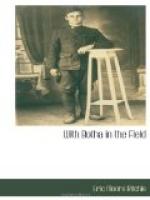Whilst awaiting orders for an advance, life at Swakopmund was in some ways quite good. There were two attractions: regimental concerts, when sanctioned, and the shore. South Africa at war differs in great degree from other parts of the world. The country has the germ in its blood. Men who have campaigned before felt the stirring in them when the South-West campaign started. The call for volunteers acted like a magnet. All sorts and conditions of men were found with the Forces in the South-West. Patriotism called them; but there called them also that deep-seated spirit of unrest which prompts so powerfully when war drums sound once again. I used to think Kipling exaggerated a trifle; now I know the truth. At the concerts on the South-West front the most astonishing array of talent was to be found. One such function in particular stands out in mind. The stage was made up of army biscuit boxes supporting rough planking outside a builder’s yard in the deep sand. At a borrowed piano belonging to some vanished resident a trooper officiated; he was clothed in a grey back shirt and ammunition boots— and displayed the daedal methods of a Fragson. Singers of every type with every kind of voice, and perfectly trained, performed. Only later did I learn that amongst the artists were half a dozen of the best performers in Johannesburg. And at the foreshore, between fatigues, drills, and spells of duty the fellows used to gather, to enjoy the one luxury of Swakopmund—the surf-bathing. Here you would meet men upon whom you never expected again to set eyes assembled literally from all over South Africa from the Cape to the Zambesi. Belonging to one regiment I met, in privates and corporals, six well-to-do farmers, a handful of solicitors, bank clerks, a sub-native commissioner or two, and the no longer youthful private secretary to one of the most eminent semi-public companies in Africa. And there we all were cut off from the outside world. Each evening we got an issue of the official Bulletin— six square inches of paper thankfully received. For the rest we had no change from the perpetual sound of the sea and the mournful note of the bell-buoy that marks the inshore shoal. Its “dong-dong, dong-dong-dong” created a perfect illusion of the call to a tiny church through the country lanes of England. Everyone who was there can still hear the old bell-buoy at Swakopmund.
[Illustration: Swakopmund from the Lighthouse: Extreme Right] [Illustration: Swakopmund: Centre] [Illustration: Swakopmund: Extreme Left]
[Illustration: Man and Beast in the Desert: both absolutely spent] [Illustration: Looking for Water in the River Bed] [Illustration: A Halt in a River Bed: General Botha has lunch]
SECTION II
THE FIRST TREK INTO THE NAMIB DESERT




